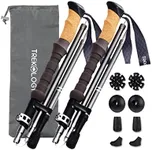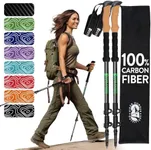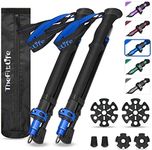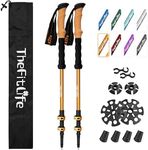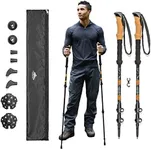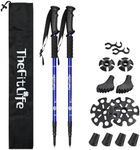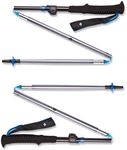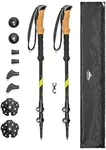Buying Guide for the Best Hiking Poles
Choosing the right hiking poles can make your outdoor adventures more comfortable and enjoyable. Hiking poles help with balance, reduce strain on your joints, and provide extra support on uneven terrain. When picking hiking poles, it's important to consider how and where you'll use them, as well as your own comfort and preferences. Understanding the key features will help you find a pair that matches your hiking style and needs.MaterialThe material of hiking poles affects their weight, strength, and durability. Most poles are made from either aluminum or carbon fiber. Aluminum poles are generally more durable and can handle rough use, but they tend to be heavier. Carbon fiber poles are lighter, which is great for long hikes or reducing fatigue, but they can be more prone to breaking under heavy stress. If you plan to hike on rocky or challenging trails, aluminum might be better, while carbon fiber is ideal for those who prioritize lightness and speed.
AdjustabilityAdjustable hiking poles let you change their length to suit different terrains or your height. Some poles are fixed-length, which can be lighter and simpler, but most hikers prefer adjustable ones for versatility. Poles with a wide adjustment range are useful if you hike on both flat and steep terrain, as you can shorten or lengthen them as needed. If you want a pole that packs down small for travel, look for models with multiple sections or folding designs.
Grip MaterialThe grip is where your hand holds the pole, and its material affects comfort and sweat management. Common grip materials include cork, foam, and rubber. Cork grips mold to your hand over time and handle moisture well, making them comfortable for long hikes. Foam grips are soft and absorb sweat, which is good for hot weather. Rubber grips provide insulation and are better for cold or wet conditions. Choose the grip that feels most comfortable in your hand and matches the climate where you'll be hiking.
WeightThe weight of hiking poles can influence how tired your arms feel after a long day. Lighter poles are easier to carry and swing, which is helpful on long hikes or for fast-paced walking. Heavier poles may offer more durability and stability, especially on rough terrain. If you plan to hike long distances or want to minimize fatigue, go for lighter poles. If you need extra support or expect to use the poles for tough trails, a bit more weight might be worth it.
Locking MechanismThe locking mechanism keeps adjustable poles at your chosen length. Common types include twist locks, lever locks, and push-button locks. Lever locks are quick and easy to adjust, even with gloves on, and are generally reliable. Twist locks are lighter but can sometimes slip if not tightened properly. Push-button locks are simple and secure but may offer less fine-tuning. If you want quick adjustments on the go, lever locks are a good choice. For simplicity and reliability, push-button or twist locks may suit you.
Tip TypeThe tip of the hiking pole is what touches the ground and affects grip and durability. Most poles have carbide or steel tips for traction on dirt, rocks, and ice. Some come with rubber covers for use on pavement or to reduce noise. If you hike mostly on trails, standard metal tips are best. If you plan to use the poles on hard surfaces or indoors, look for poles with removable rubber tips.
Shock AbsorptionSome hiking poles have built-in shock absorbers to reduce impact on your wrists and arms, especially when going downhill. This feature can make hiking more comfortable, particularly for people with joint issues. However, shock-absorbing poles can be slightly heavier and more expensive. If you have sensitive joints or plan to hike on steep descents, shock absorption may be helpful. If you prefer a lighter, simpler pole, you might skip this feature.
